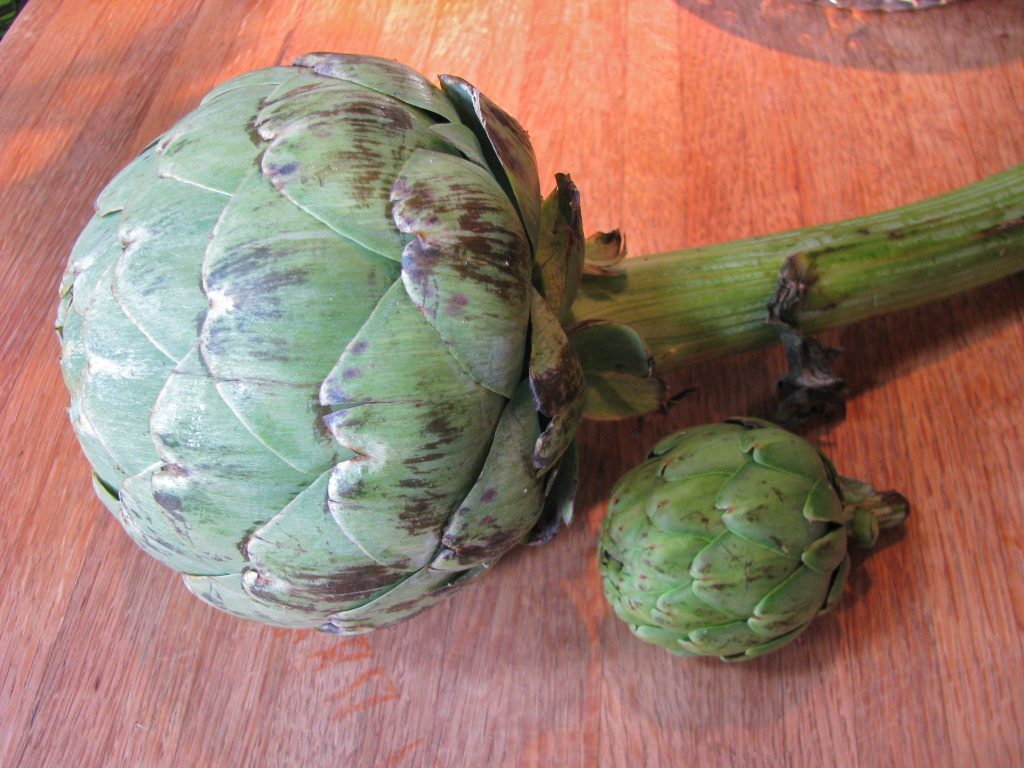When New York Choked the Artichoke Trade

Pictured above (via a food blog) are two artichokes — a regular, full-sized one and a baby artichoke. They’re the same food, with the latter just being a tiny version of the former. They’re good grilled, roasted, or sauteed and can be used in all sorts of dishes, from salads to niche sandwiches. You can usually find both sizes in most grocery stores in the United States, although baby ones can sometimes be difficult to find during the winter.
Especially if it was the December of 1935, and if you were in New York City. That’s because, for a brief moment back then, you couldn’t legally buy, sell, or even possess a baby artichoke within the city limits.
Artichokes — baby or otherwise — are just another vegetable, and unlike some other things that grow like certain herbs and mushrooms, aren’t likely to get you high or cause you to hallucinate. In other words, they’re safe for human consumption and typically wouldn’t make sense to regulate. But when NYC mayor Fiorello LaGuardia cracked down on the produce, that didn’t matter. He wasn’t trying to prevent artichoke abuse — he was hoping to slow down the mafia.
Artichokes are native to the Mediterranean area and are a staple of Italian cuisine. When Italians immigrated to the United States in the mid-to-late 1800s, though, most left the artichoke behind; those immigrants lived in New York, Chicago, and other colder American cities in which artichokes wouldn’t flourish. That changed in the early 1900s. Some Italian immigrants migrated to northern California and started farms, and a few realized that the more temperate climate was perfect for producing artichokes. Today, Italy still leads the list of most artichokes grown, but the United States is in the top 10, with almost all notable American growers located in California.
These growers immediately had a hit on their hands. As Atlas Obscura notes, starting in around 1910, “realizing that Italian immigrants would pay a pretty penny for artichokes, Californian farmers sent their produce east to Boston, New York, and Philadelphia. By 1935, Monterey County’s [a county in northern California] choke market grossed about $666,000 per year, or $12.5 million in 2020 dollars.” And the Italian mob in New York City wanted a piece of that action. An underboss of the Morello crime family named Ciro Terranova cornered the market on baby artichokes, earning himself the nickname “The Artichoke King.” How he obtained such control is unclear — it most likely involved violence or threat thereof — but one thing is virtually undisputed: by the early 1930s, almost every single baby artichoke in New York City came through the Union Pacific Produce Company, a company controlled by Terranova and the Morellos. And they used their monopoly power to extract a premium for their produce.
When LaGuardia ran for mayor in 1933, he promised to crack down on organized crime. The artichoke trade became an easy target. On December 21, 1935, he and a small army of police officers went to a large market in the Bronx and announced that starting in a few days, a ban on the “sale, display and possession” of baby artichokes, per the New York Times (pdf). LaGuardia estimated that the “racketeers, thugs, and punks” behind the baby artichoke monopoly earned roughly $1 million per year — north of $20 million in today’s dollars — per the Times. And the ban was open-ended — it would be in effect until the mob got out of the artichoke business. Some decried the ban as being incompatible with liberty; a New York Times opinion piece (pdf), for example, stated that “you do not throw out the baby with the bath, and you must not throw out the artichoke with the Artichoke King.” But others welcomed the effort to take a bite out of crime.
But any controversy was short-lived, and for good reason: the ban didn’t last very long. Three days after the baby artichoke ban went into effect, it was done, because it had worked. As the New York Times reported (pdf), “the five companies which import the commodity from California signed an agreement [ . . . ] pledging themselves to sell directly to retailers and market dealers.” The Union Pacific Produce Company shut down, and LaGuardia revoked the ban.
Bonus fact: Jerusalem artichokes, seen here, aren’t artichokes — and they aren’t from Jerusalem, either. The artichokes that we eat are the flower buds from artichoke plants, while Jerusalem artichokes (also sometimes called “sunchokes” in the United States” are actually root vegetables from a type of sunflower. The “Jerusalem” part of their name comes from this flower; the Italian word for “sunflower” is “girasole,” and over time, English speakers transformed that into “Jerusalem.” The sunflowers that create Jerusalem artichokes, as The Spruce Eats notes, are native to North Africa, not the Middle East.
From the Archives: The Bathrobe Defense: How a mob boss used some not-so-fancy attire to keep out of prison.
